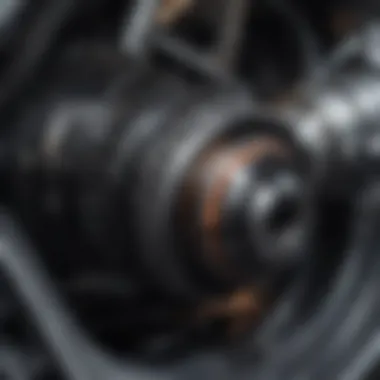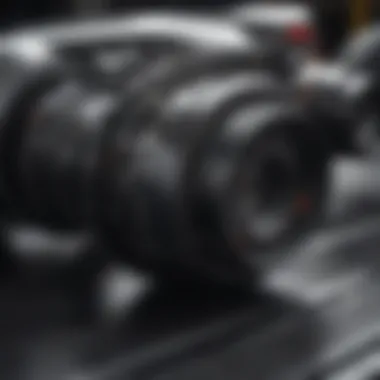Exploring Manual Racing Transmissions in Modern Vehicles


Intro
Manual racing transmissions have carved a niche in the world of automotive engineering, providing drivers with a hands-on, intimate connection to their vehicles. Unlike their automatic counterparts, which have gained popularity for everyday driving comfort, the allure of manual transmissions remains alive and well, particularly in racing circles. This article will navigate the intricate tapestry of manual racing transmissions, illustrating their mechanics, advantages, and the latest innovations that have seeped into this traditional realm.
We’ll explore why enthusiasts still favor these systems, not just for their raw performance but also for the driving experience they engender. Moreover, we will look into how advancements in technology challenge the cliché that automatic systems reign supreme.
Automotive Features and Innovations
This section dives into the cutting-edge technologies that elevate manual racing transmissions, making them more relevant than ever. The love for manual shifting isn't merely nostalgic; improvements have transformed their function and appeal in the dynamic landscape of modern automotive engineering.
Overview of Latest Technologies
Manufacturers have been tinkering under the hood, refining manual transmissions. Newer models use lightweight materials that enhance strength and reduce weight. For instance, the aluminum cases that house gears are now common, as they resist deformation while contributing to overall weight savings. Additionally, the use of advanced gear designs, such as helical and straight-cut gears, improves shifting response.
Modern manual transmissions now frequently include features like rev-matching technology, mimicking heel-and-toe downshifts, allowing even novice drivers to experience smooth transitions, a technology that was once exclusive to seasoned racers. This adds an element of control that many find exhilarating.
In-Depth Look at Electric/Hybrid Vehicles
While pure racing enthusiasts often think only of gasoline engines and high RPMs, electric and hybrid vehicles are starting to join the mix. Manual elements are appearing in these models, albeit in unique ways.
Traditionally, electric cars utilize single-speed transmissions. However, Porsche, for instance, has developed a dual-clutch system in its hybrid setups that emulates manual engagement. The experience of shifting gears can enhance driver engagement, drawing parallels with conventional manual systems, even if in a different context.
Analysis of Autonomous Driving Systems
The rise of autonomous vehicles presents challenges for manual racing transmissions. As self-driving technology solidifies its presence on the roads, the importance of manual transmission fades in many norms of daily driving. However, the racing world, with its emphasis on driver skill and control, still champions manuals.
Evaluation of AI in Automotive Solutions
Artificial Intelligence is beginning to seep into vehicle balancing and stability control systems, enhancing manual transmission performance even further. Thoughtful algorithms analyze driving patterns and optimize performance based on real-time data, providing an improved driver experience without detracting from the joys of manual involvement.
Finale of the Section
Collectively, these advancements highlight the dichotomy between embracing modern technologies while preserving the quintessential aspect of manual driving. The evolution of manual transmissions has not only adapted to meet market demands but has also kept the spirit of racing alive. The upcoming sections will tackle other crucial areas, including maintenance tips to ensure longevity and performance of these systems, and trends shaping the future of automotive engineering.
Prelude to Manual Racing Transmissions
The realm of automotive engineering has seen immense advancements over the decades, yet some elements remain incredibly popular amongst enthusiasts. One such component is the manual racing transmission. This configuration not only delivers an engaging driving experience but also plays a crucial role in enhancing vehicle performance. Understanding manual racing transmissions is vital for anyone serious about automotive dynamics and competition driving.
Definition and Basic Functionality
In simplest terms, a manual racing transmission allows the driver to control gear shifting directly, as opposed to relying on a more automated system. This means the driver can select gears with precision and timing that can significantly impact speed and acceleration.
When a driver engages the clutch and shifts gears, the power generated by the engine travels through the gearbox, which is meticulously calibrated for performance. Each gear ratio is tailored, offering unique advantages depending on vehicle needs. This level of control translates to better acceleration, engine response, and more efficient use of power. It’s like cutting through the fog when you’re used to driving a car with an automatic; the direct connection with the vehicle becomes palpable.
Historical Context and Evolution
The journey of manual transmissions in racing cars began long before current technology came to fruition. Early automobiles primarily featured manual setups, as automatics weren’t feasible at the time. Over the years, as automakers sought to enhance driving performance, manual transmissions evolved significantly. Initially, designs were rudimentary, often using a simple four-speed gearbox, and shifters were less intuitive.
However, as competition intensified, engineers began to innovate. The shift from a constant mesh (solid gears locked into place) to synchromesh systems meant smoother transitions between gears without grinding, and advancements like dog engagement systems threw traditional models for a loop. With this development, races became not just a matter of speed but also of strategy and nimbleness in gear management. Drivers began to learn the nuances of timing each gear change with engine RPMs, turning manual racing transmissions into instruments of mastery.
In today’s racing landscape, the evolution continues, with sequential gear shifts and innovative materials that enhance durability while minimizing weight. Each advancement speaks volumes about how far this technology has come, adapting to both competitive needs and passionate driving experiences.
"In a world where speed meets precision, the manual racing transmission shines, illustrating that tradition and technology can coexist beautifully."
As we navigate through this article, we’ll uncover more about the inner workings and various components that mark the uniqueness of manual racing transmissions. Understanding their role and structure is essential for anyone looking to appreciate or leverage the full capabilities of a high-performance vehicle.
Core Mechanics of Manual Racing Transmissions
Understanding the core mechanics of manual racing transmissions is critical in the study of modern automotive engineering. These components are not just about shifting gears; they play essential roles in how power is generated, delivered, and managed within a vehicle. Manual racing transmissions bring forth a unique blend of precision, weight savings, and driver involvement that cannot be easily replicated by their automatic counterparts.
The Gearbox: Structure and Components
The gearbox is the heart of any racing transmission system. It's more than just a housing for gears; it embodies several key components that work harmoniously to optimize performance and responsiveness.
Gears
Gears in a racing transmission are designed with meticulous attention to detail, focusing on ratios that enhance acceleration, velocity, and efficiency. Their primary function is to provide a range of torque outputs to match various speed conditions. Most common choices include straight-cut gears, which provide immediate engagement and are less prone to damage during hard acceleration. This design allows for quick gear changes, essential for racing situations. However, an inherent disadvantage is the noise level; straight-cut gears can be quite loud compared to helical gears, which are smoother but may not provide the same efficiency.
The distinct feature of these gears is their position: internal meshing, allowing for a lower profile in the overall gearbox structure. This reduces weight, a crucial factor in competitive racing. The trade-off, however, comes from the potential for rapid wear under extreme conditions, necessitating frequent maintenance and checks.


Synchronizers
Synchronizers serve as the gatekeepers of a smooth gear transitioning experience. Their role is pivotal in matching the speeds of the gear and the shaft. This means that they help prevent grinding during shifts, thereby prolonging the lifespan of both the gears and the overall transmission.
Most modern racing gearboxes utilize cone-type synchronizers, which allow for quicker engagement and smoother shifts. The key characteristic of these systems is their ability to facilitate quick and precise gear changes, which is invaluable in racing scenarios where every millisecond counts. However, they come with a caveat: in high-stress situations, like prolonged racing, they can heat up, causing performance issues when not monitored properly.
Shifter Mechanism
The shifter mechanism acts as the interface between the driver and the gearbox. This component allows for intentional gear selection and is designed to provide a tactile feel, essential in competitive driving. A prominent choice is the short-throw shifter, which reduces the distance between gear changes, allowing for faster response times.
One unique feature of modern shifter mechanisms is the inclusion of adjustable settings, allowing drivers to tailor the feel of engagement to their personal preference. While this can enhance driver satisfaction and comfort, adjustments can become complex, adding layers of decision-making during critical racing moments.
Power Transfer and Torque Management
The handling of power transfer and torque management underpins the operational efficiency of a manual racing transmission. In essence, this process determines how well a vehicle accelerates, maintains speed, and handles during cornering. Efficient power transfer is critical; it ensures that the engine's output is effectively channeled through the transmission to the wheels. Manual racing transmissions excel here through a direct connection between the engine and drivetrain. Unlike automatics, which use torque converters that introduce slippage, a manual setup allows for a more immediate and responsive power delivery.
Additionally, torque management is instrumental in maintaining stability during high-speed maneuvers. By allowing the driver to change gears at will, manual systems enable fine control over the vehicle's acceleration. For instance, shifting down into a lower gear during cornering can help control oversteer, providing a level of engagement that automatic transmissions simply can’t match.
In summary, the core mechanics of manual racing transmissions highlight the intricate interplay between gears, synchronizers, and shifter mechanisms. Together, they define the performance and driver experience, cementing the relevance of manual transmissions in the world of racing and high-performance vehicles.
Advantages of Manual over Automatic Transmissions
In the modern world of automotive engineering, the debate between manual and automatic transmissions is as lively as a NASCAR race. For racing enthusiasts and everyday drivers alike, understanding the advantages of manual transmissions can be paramount. Facing the thrill of control, drivers often find that a manual transmission offers not just engagement, but also performance benefits that could give them an edge on the road or racetrack.
Driver Engagement and Control
One of the most palpable benefits of manual transmissions lies in the level of driver engagement. Operating a vehicle with a manual gearbox brings a sense of direct connection with the car that many enthusiasts cherish. The tactile feedback from the shifter, the audible clunk of gears engaging, creating a more involved driving experience. This connection fosters greater awareness of the vehicle's dynamics as drivers adjust shifts to match engine speed, allowing for seamless power delivery and enhanced control.
For many, developing a skill set around shifting gears can feel like learning a craft. That process not only hones one’s driving abilities but also builds a deeper appreciation for the mechanics of the car. Shifting at the right moment can drastically alter the outcome in a competitive scenario, showcasing why seasoned drivers tend to favor manual setups.
Consider the sentiment: when you take command of each shift, you aren’t just driving; you are pilotting a finely tuned machine. This kind of control can be crucial when pushing limits in performance situations, such as racing, where maximizing throttle response can lead to significant time advantages.
Performance Efficiency and Responsiveness
When dissecting performance, one can’t ignore the responsiveness inherent in manual transmissions. The connection between the driver and the vehicle becomes even more critical when integrating this with performance metrics. Manuals tend to exhibit less parasitic loss compared to automatics. This translates to a more instantaneous transfer of power from the engine to the wheels. When the driver decides to accelerate, the vehicle responds almost like a coiled spring—quickly and efficiently.
This responsiveness is further enhanced during high-demand circumstances. When a driver downshifts to negotiate a corner or jostles through traffic, the control of the power band often feels more intuitive in a manual. Drivers can downshift early in preparation for an immediate acceleration out of a turn, harnessing the engine's power effectively.
In terms of efficiency, a well-operated manual can yield better fuel economy during everyday driving. While not universally true, skilled drivers who master gear selection can find ways to operate in optimal rev ranges, ultimately extracting more miles per gallon than their automatic counterparts. The potential for improved efficiency and performance together makes a compelling case for choosing a manual transmission,
"In racing, what you feel is often as important as the numbers on a telemetry screen. Manual transmissions give you that awareness."
In Closing
The advantages of manual transmissions, particularly in driver engagement and performance efficiency, can be enticing for those who value a more active role in their driving experience. While automatic technologies continue to advance, the relationship between a driver and a manual gearbox remains unmatched for many. Knowing how to harness this potential can truly transform not just the experience behind the wheel, but the understanding of automotive performance as a whole.
Design Variations in Manual Racing Transmissions
Understanding the diversity in manual racing transmissions isn't just an academic pursuit; it holds real value for both performance enthusiasts and everyday drivers alike. Different designs cater to specific needs, preferences, and driving conditions. This section emphasizes the distinct varieties in manual transmission designs and how they contribute to overall vehicle performance.
Traditional vs. Sequential Transmissions
Traditional and sequential transmissions are two distinct types serving different purposes in the automotive world.
Traditional transmissions typically use a gate-shift mechanism. When shifting, the driver moves the gear lever through a defined pattern. This pattern—often H-shaped—requires more effort and time to engage gears, especially at high speeds. Formula one vehicles and other racing machines at the top levels frequently opt for this type because the driver has the satisfaction of feeling every shift. Enthusiasts often argue that this tactile feedback enhances driver engagement, giving them a closer connection to the vehicle.
However, traditional systems have their downsides. With numerous gears to navigate, there can be a slight lag, which may hinder swift acceleration during critical moments, such as overtaking.
On the other hand, sequential transmissions offer a completely different handling experience. Instead of an H-pattern, they use a linear shift mechanism, where the driver pulls or pushes a lever to shift up or down. This design provides faster gear changes, minimizing any potential delay when fractions of a second count.
- Advantages of sequential transmissions include:
- Rapid Gear Changes: Quick engagement can significantly reduce lap times.
- Intuitive Shifting: The straightforward mechanism limits chances of getting stuck in the wrong gear.
- Driver Focus: Less time spent shifting means more attention can be placed on the road.
However, they also require skill to manage effectively, particularly when controlling the power during changes.
The choice between these designs often boils down to personal preference and specific racing applications. Seasoned drivers generally favor sequential setups for competitive racing. However, for those who relish the artistry of driving, traditional transmissions can provide a richer experience. The best of both worlds may come from understanding when to utilize each design in varying race conditions.
Dog Engagement Systems


A dog engagement system is essential to speeding up gear shifts without the usual grind that one might expect. Unlike the traditional synchro systems, which rely on synchronizers to match gear speeds during engagement, dog engagement systems employ dogs and slots or pegs to create a direct connection between gears.
In layman’s terms, think of it like how a dog barks at its owner for a reward. The system hooks like a canine latch—no waiting for parts to match up, just a firm and immediate connection. This leads to:
- Faster Gear Change: As there’s no need for synchronization, shifts happen much quicker.
- Reduced Weight: The structure often allows for a lighter overall design, which is vital in a racing setup.
- Enhanced Durability: Fewer moving parts mean there’s less that can go wrong over time, making it a reliable choice for serious racers.
Nevertheless, mastering such systems might require some learning. Not every driver can easily adapt to the abrupt nature of dog engagement, so it’s best suited for those who have some experience under their belts.
In summary, different design variations in manual racing transmissions influence not just how a car drives but also how drivers connect with their machines. Traditional and sequential setups bring distinct feelings and performance benefits, while dog engagement systems push the boundaries of gear shifting efficiency. Recognizing the strengths and weaknesses of each type is crucial for anyone looking to optimize their automotive experience.
Technological Innovations Shaping Manual Transmissions
In the landscape of automotive engineering, manual racing transmissions are witnessing a renaissance fueled by technological innovations. These advancements are not solely about making the transmissions more efficient; they are fundamentally transforming how drivers interact with their vehicles. From the implementation of hybrid systems to the seamless integration with modern engine management, these innovations are shaping the future of manual transmissions in ways that cater to both performance and sustainability.
Hybrid Systems and Their Impact
Hybrid systems are becoming a focal point in the discussion regarding manual transmissions. Traditionally, the manual system was viewed as an isolated component, somewhat detached from the engine’s electronic management. However, today’s hybrids blend combustion engines with electric motors. This fusion creates a unique set of performance dynamics particularly appealing in the racing realm. Drivers harnessing hybrid systems not only have the advantage of increased power but also improved torque delivery. This means acceleration can feel more instantaneous, enhancing the overall driving experience.
There are several key benefits of incorporating hybrid systems into manual transmissions:
- Efficiency: The combination of electric and combustible power sources leads to improved fuel efficiency, a factor that cannot be overlooked in both racing and everyday driving.
- Performance: Hybrid systems allow for rapid torque response, which means drivers can achieve a significantly better throttle response, translating to faster lap times.
- Customization: Many hybrid systems offer adjustable settings. Drivers can select power modes that fit their racing style or conditions. This flexibility can be pivotal in achieving optimal performance on different tracks.
While there are clear advantages, transitioning to hybrid systems does come with challenges. Drivers need a grasp not only of the manual mechanics but also of the electric systems working in tandem. Training and skill development become paramount as they adapt to this advanced technology.
Integration with Modern Engine Management
The integration of manual transmissions with modern engine management systems represents another leap forward in racing technology. In the past, shifting was a tactile experience with minimal feedback between gear selection and engine performance. Today, however, sophisticated software can monitor various parameters in real-time, allowing for a more harmonious operation between the driver and the vehicle.
This is how modern engine management enhances manual transmissions:
- Real-Time Adjustments: Modern systems can adjust fuel mixtures and ignition timing based on the current speed and gearing, thus optimizing performance dynamically. This means the engine can run in its most efficient range during any phase of a race.
- Data Feedback: Many racing teams now employ telemetry that provides instant data to both drivers and engineers. They can analyze the vehicle’s performance after each run, identifying the best tuning setups for future races.
- Driver Assistance Features: Some advanced systems offer features like auto-blipping when downshifting; this helps maintain stability, which can be quite beneficial in high-speed racing environments.
In essence, the integration of manual transmissions with engine management systems does not detract from the driving experience. Rather, it enriches it, allowing drivers to focus more on strategy and less on the mechanics, ensuring a balanced and thrilling performance on the track.
"Innovations are the heart of automotive progress, merging the tactile joy of manual driving with the precision of technology."
The evolution of manual racing transmissions is thus characterized by these technological innovations, bridging the gap between traditional driving sensations and modern engineering marvels. As we move forward, it will be fascinating to see how these elements shape the landscape of racing and everyday automotive applications alike.
Impact on Vehicle Performance and Handling
When discussing the performance of a vehicle, one cannot overlook the role of the transmission, particularly manual racing transmissions. These components form the bridge between the engine's power and the drive wheels. The impact on vehicle performance and handling is profound, with specific features tailored to enhance both acceleration and stability. In essence, the right manual transmission can play a pivotal role in how a car responds to the driver’s intentions, directly affecting both speed management and cornering dynamics.
Acceleration and Speed Management
Acceleration is a critical aspect of performance, and manual racing transmissions offer distinct advantages in this area. Unlike their automatic counterparts, manual transmissions provide drivers with a more immediate control over engine power. This can lead to quicker bursts of speed when needed. Here’s why that’s important:
- Driver Control: With manual transmissions, drivers can decide precisely when to shift gears. This flexibility allows for optimal power delivery to the wheels, which can translate to faster acceleration times.
- Power Band Utilization: Manual gearboxes enable drivers to keep the engine within the ideal power band, maximizing torque when needed while minimizing lag. Such efficiency can be essential on the track, where fractions of a second are crucial.
- Engine Braking: When downshifting in a manual, drivers can employ engine braking to assist in slowing down. This technique can enhance acceleration due to the reduced reliance on the brake system.
- Weight Distribution: Manual transmissions typically weigh less than automatic systems, leading to overall weight reduction. A lighter vehicle accelerates faster due to improved power-to-weight ratio.
In race conditions or spirited drives, the effectiveness of acceleration offered by a manual transmission can mean the difference between victory and defeat. Every gear change becomes an opportunity for the driver to harness their skill and instinct, resulting in an engaging driving experience.
Cornering Dynamics and Stability
Turning is another central aspect of automotive handling, significantly impacted by the choice of transmission. Here’s how manual transmissions contribute to enhanced cornering dynamics:
- Predictable Power Delivery: Manual gearboxes afford drivers unparalleled power control in turns, allowing them to modulate engine output based on real-time feedback. This predictability helps in maintaining stability, especially in high-speed maneuvers.
- Rev Matching: Drivers skilled in manual driving can perform rev matching when downshifting, allowing the engine speed to synchronize with wheel speed. This practice minimizes destabilizing weight transfer that can occur during rapid gear changes while cornering.
- Weight Bias and Handling: Since manual transmissions are often lighter, they allow for a more balanced chassis, enhancing overall handling characteristics. A well-balanced car will respond more predictably when cornering, providing enhanced confidence to the driver.
- Driver Engagement: Engaging the driver in the vehicle operation is crucial, especially during quick directional changes. A manual gearbox keeps the driver focused on their inputs, creating a more immersive driving experience that can improve handling performance.
"Choosing a manual transmission is not just about enjoying the drive. It's about mastery over the machine, enhancing performance in every facet, from acceleration out of corners to maintaining stability under pressure."
Driver Experience: Manual vs. Automatic
The debate between manual and automatic transmissions often captivates a range of automotive enthusiasts. It encapsulates not just a choice of driving method but touches upon the very essence of what it means to be a driver. Whether behind the wheel of a spirited sports car or a practical hatchback, the transmission style can dramatically shape the experience. Here, we will take a closer look at the notable differences that set manual racing transmissions apart, especially in the context of performance, engagement, and adaptability.
Skill Development and Training
Driving a manual transmission car requires a certain set of skills that can be seen as both a rite of passage and a challenge. Engaging with a manual gearbox instills a deeper understanding of vehicle mechanics as the driver learns to synchronize movements between the clutch and gear lever. Here are some key aspects:
- Mastery of Timing: When changing gears, the driver learns to find the right balance between disengaging the clutch, shifting the lever, and re-engaging smoothly. This act demands precision—a skill honed over time.
- Fostering Patience: Unlike the instant gratification that comes from automatic gear changes, manual transmissions force the driver to slow down and think, developing a sense of control over the vehicle.
- Practical Driving Knowledge: Becoming proficient in a manual transmission translates into better overall driving skills. Drivers become more attuned to engine sounds, power bands, and vehicle behavior. For instance, the difference between the feel of low-end torque and peak horsepower is palpable when you shift gears manually.
Through these lessons, a driver might find themselves better prepared for various scenarios, like racing on the track, where every millisecond counts. If one is looking to enter competitive driving culture, mastering a manual transmission is often seen as a prerequisite.


Adapting to Various Driving Conditions
Another significant aspect of the driver experience is how well a manual racing transmission adapts to diverse conditions. A manual gearbox can provide added flexibility, which proves advantageous in various driving scenarios:
- Optimized Performance on Different Terrains: Manual drivers can quickly adapt their speed and power delivery based on terrain conditions. Whether it’s a muddy trail, winding mountain roads, or a slick racetrack, the driver can select the most appropriate gear to maintain momentum or improve traction.
- Tactical Gear Selection: Drivers have the ability to change gears at will, allowing them to respond dynamically to changes in the environment, be it a sudden incline or a sharp curve.
- Fuel Efficiency Control: In certain conditions, especially during long drives, a manual transmission can be manipulated for better fuel efficiency through thoughtful gear shifting—something that automatic systems often overlook.
This level of engagement not only enhances the driving experience but also sharpens a sense of connection between the driver and the machine. Aspects of environmental responsiveness and quick adjustment often set devoted manual racers apart from their automatic counterparts.
"The thrill of the manual shift is not just mechanical; it’s an art form, a dance between man and machine that evolves with the road ahead."
Maintenance Considerations for Manual Racing Transmissions
Maintaining a manual racing transmission is not just a routine task; it’s crucial for the overall performance, longevity, and reliability of the vehicle. Without proper care, even the most finely engineered machines can suffer, leading to a drop in efficiency and potential breakdowns. Let's dive into what this maintenance entails.
Routine Checks and Fluid Management
Regular checks should be part and parcel of owning a manual racing car. The importance of frequent inspections cannot be overstated. The transmission fluid, often an unsung hero in ensuring smooth gear transitions and optimal performance, demands attention. This fluid acts like the lifeblood of the gearbox, facilitating the lubricating processes while also dissipating heat generated during operation.
- Check Fluid Levels: It’s key to keep an eye on the transmission fluid levels. Low fluid can cause severe damage. Most experts suggest checking levels every few weeks, especially if the transmission is frequently used in high-intensity situations, like racing.
- Inspect Fluid Condition: Not only the quantity matters, but the quality of the fluid itself should be monitored. If it appears dark, gritty, or has a burnt smell, it’s time for a change. Failing to replace degraded fluid can lead to premature wear of crucial components.
- Change Intervals: Depending on usage, many car enthusiasts recommend changing the transmission fluid at least once a year or even more frequently for racing applications. This helps maintain the correct viscosity and lubrication properties the transmission needs to thrive under stress.
Common Issues and Repair Strategies
Being aware of common issues plaguing manual racing transmissions can save both time and money. Drivers should keep their eyes peeled for early signs of trouble. A few common issues include:
- Grinding Gears: If the gears are grinding, it may indicate a problem with the synchronizers or insufficient fluid. Diagnosing and resolving this is vital, as continued grinding can lead to significant damage.
- Difficulty Shifting: This can stem from several sources including worn-out linkage components, low fluid levels, or even issues with the clutch. Paying close attention to the shifter’s behavior can give crucial hints toward what's amiss.
- Leaking Fluid: Any presence of fluid beneath the vehicle should be regarded seriously. Addressing leaks promptly is essential, as they can lead to diminutive fluid levels, increasing the risk of failure.
Repair Strategies
Upon identifying issues, knowing how to address them is important. Here are a few strategies:
- Fluid Replacement: As mentioned earlier, regularly replacing old fluid should be a top priority. It’s a relatively simple fix that can prevent more significant problems later on.
- Adjusting the Clutch: If the clutch is misaligned, it can cause shifting difficulties. Calibration and adjustments may only require a basic toolset and some insight on the specific vehicle model.
- Professional Assistance: For more serious issues like gear damage or synchro failure, seeking help from a qualified mechanic can be the best course of action. They can ensure repairs are made correctly and efficiently, preventing future issues.
Always remember, a stitch in time saves nine. The earlier you address issues, the lesser the risk of encountering a bigger problem.
In summary, routine checks and fluid management go hand-in-hand in ensuring the health of manual racing transmissions. Understanding common issues and implementing effective repair strategies can make a substantial difference in performance and reliability, keeping an enthusiasts' pride and joy on the track where it belongs.
Future Trends in Manual Transmission Technology
As automobiles hurtle into a new age where technology meets tradition, the landscape of manual transmissions is evolving rather than fading away. The future trends in manual transmission technology not only highlight the adaptability of these systems but also emphasize their critical role in performance, efficiency, and driver engagement. Even as automated options become more prevalent, the manual box has cemented its place, particularly among enthusiasts and in racing scenarios. It’s vital to analyze how contemporary innovations are steering this segment of engineering towards and beyond expectations.
The Role of Artificial Intelligence
Artificial intelligence is becoming a powerful ally in the world of manual transmissions. At first glance, it might seem odd pairing such a driver-centric feature with AI. However, the integration of smart technology is set to revamp how drivers experience manual shifting. For instance, algorithms that analyze driving patterns can be used to enhance gear ratios in real time. This would allow drivers to enjoy the tactile feedback of shifting gears while benefitting from an optimized performance that adapts to road conditions.
Moreover, with the advent of machine learning, sensors can generate data about driver behavior and instantly suggest optimal shifting points. It’s akin to having a coach sitting right beside you, fine-tuning your performance without hindering your autonomy.
Here are some potential advantages of AI integration in manual transmissions:
- Real-time data analysis for enhanced efficiency
- Personalized shifting strategies based on user habits
- Improved safety through adaptive performance metrics
“In a world increasingly dominated by automatic systems, enhancing the manual experience through AI represents a leap into the future without losing touch with tradition.”
Sustainability and Environmental Concerns
The automotive industry is under scrutiny, with environmental concerns driving innovation at an unprecedented pace. This is particularly true for manual transmission technologies, which are often perceived as less efficient than their automatic counterparts. Yet, there’s potential to flip the narrative entirely.
Manual gearboxes can offer weight advantages that translate into better fuel economy. This is crucial amidst rising fuel prices and growing pressure on carbon footprints. By optimizing materials used in the construction of gear components and exploring lightweight designs, manufacturers can further enhance the sustainability of manual transmissions.
Additionally, as electric and hybrid engines gain traction, the manual transmission must evolve to remain relevant. For instance, developers are experimenting with integrating gearboxes into hybrid setups to provide a more engaging driving experience while optimizing energy consumption.
Key considerations include:
- Utilizing eco-friendly materials in manufacturing
- Reducing energy waste through optimized gear designs
- Crafting guidebooks for drivers on fuel-efficient driving with manual systems
The End
In wrapping up this extensive look at manual racing transmissions, it becomes clear that these systems are not just relics of the automotive past but integral components that define both the performance and the driving experience in modern vehicles. Every gear change, every shove of the shifter, and every rewarding pop of the exhaust when downshifting adds layers of engagement that automatic transmissions often miss. The importance of understanding these mechanisms lies in their transformative impact on vehicle dynamics and driver skill.
Summary of Key Points
- Driver Engagement: Manual transmissions heighten the level of interaction between the driver and the car. They offer a hands-on experience that can be thrilling and fulfilling.
- Performance Efficiency: They provide better torque management and acceleration. This efficiency is essential for high-performance settings where every millisecond counts.
- Technological Innovations: Advances in design, like sequential systems and hybrid technologies, are pushing the envelope of what manual racing transmissions can achieve.
- Maintenance Considerations: Understanding the maintenance aspect helps in keeping these systems functioning optimally, which is a crucial point for enthusiasts.
- Future Trends: The incorporation of AI and a growing emphasis on sustainability could shape the future landscape of manual transmissions, paving the way for modern adaptations without losing their core identity.
Final Thoughts on Manual Racing Transmissions
Manual racing transmissions serve as a symbol of driver-centric engineering. They bridge the gap between machine and human, allowing for precision and personal expression on the track and the road. While the automotive world may trend towards automatic systems filled with technology, the appeal of manuals lies in their simplicity and the raw connection they provide. As technology advances, it's promising to see how manufacturers will blend the old charms of manual gearboxes with the innovations of the future. Ultimately, for purists and newcomers alike, manual transmissions are a testament to the art of driving. This appreciation will continue as long as there are enthusiasts willing to embrace the challenge and thrill of manual shifting.







